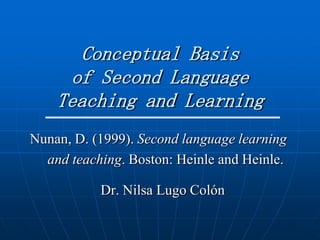
Conceptual basis of l2 teaching and learning
- 1. Conceptual Basis of Second Language Teaching and Learning Nunan, D. (1999). Second language learning and teaching. Boston: Heinle and Heinle. Dr. Nilsa Lugo Colón
- 2. Concept Map Traditional vs. Humanistic New view of Learner Experimental Psychology language needs Learning Communicative Humanistic Language Tradition Teaching (CLT) Deductive, inductive learning Conceptual Basis of SLTL Negotiations Defining Defining Learner Learner Task ladder as a relative learner- tasks contributions Input concept centered Task-based Learner- Negotiated language centered Curricula learning Education Learning by Developing Adult doing learner education skills at negotiation
- 3. Humanistic Psychology • Attempts to make sense of experience at the point where sociology and psychology intersect. • Captures the fact that humans are simultaneously looking inwards and operating outwards. • Any attempt to understand what motivates behavior must necessarily capture the individual in relation to the group.
- 4. Experiential Learning • Facilitates personal growth • Helps learners adapt to social change • Takes into account differences in learning ability • Is responsive both to learner needs and practical pedagogical considerations • Builds a bridge from the known to the new by taking the learner’s perceptions and experiences as the point of departure for the learning process
- 5. Communicative Language Teaching • In the 1970’s, a richer conceptualization of language began to emerge. • Language was seen as a system for the expression of meaning, as opposed to just a system of abstract syntactic rules. • Aim of language teaching is to help learners develop skills for expressing different communicative meanings. • CLT led to the emergence of task-based approaches to language teaching.
- 6. Learner-centered Education • In the learner-centered classroom, key decisions are made with reference to the learner: what skills will be taught how skills will be taught when skills will be taught how skills will be assessed Learner Input • Learners are systematically educated in the skills and knowledge they will need in order to make informed choices about what they want to learn and how they want to learn.
- 7. Negotiated Curricula • The views of the learners as well as the pedagogical agenda of the teacher are satisfied through a process of give-and- take. • What gets taught and how it is learned are arrived at through discussion and compromise. • Learners move along a negotiation continuum.
- 8. Negotiation Continuum Step 1: Make instruction goals clear to learners. Step 2: Allow learners to create their own goals. Step 3: Encourage learners to use their second language outside the classroom. Step 4: Raise awareness of learning processes. Step 5: Help learners identify their own preferred styles and strategies. Step 6: Encourage learner choice. Step 7: Allow learners to generate their won tasks. Step 8: Encourage learners to become teachers.
- 9. Task-based Language Learning • Target tasks – enable learners to use language to do the hundred and one things people do in everyday life, at work, at play, and in-between. • Pedagogical tasks – classroom work that involves learners in comprehending, manipulating, producing, or interacting in the target language.
- 10. Three Principles of Task Design • Authenticity Principle Sample of spoken and written language that have not been specifically written for the purpose of teaching language. • Form/Function Principle Design tasks that require learners to use inductive and deductive reasoning to develop their won understanding of the relationship between from and function. • Task Dependency Principle Each succeeding task in the instructional sequence flows out of, and is dependent on, the one that precedes it. Sequence tasks from reception to production Listening and reading comes before speaking and writing.